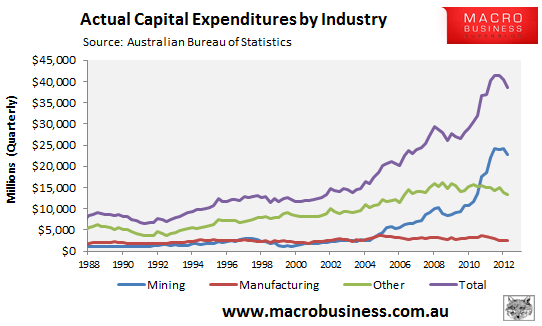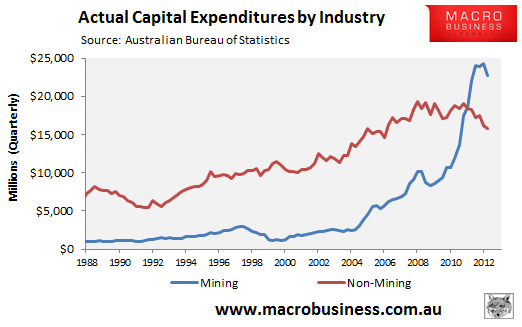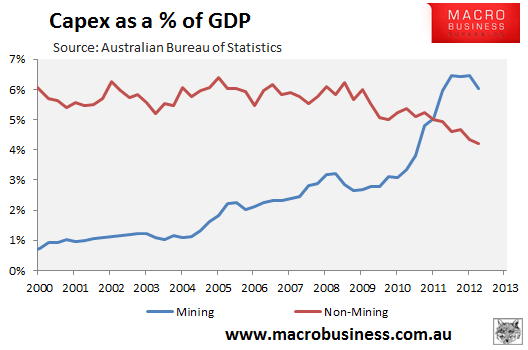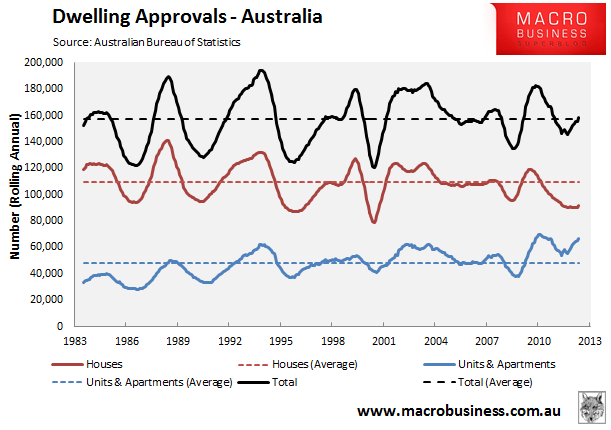
Today, Business Spectator’s Jessica Irvine published a rather optimistic article about the Australian economy’s transition away from mining-led growth. Let’s take a look:
There is more than a little uncertainty that we can successfully make the leap from a decade of mining-sector fueled growth to a recovery in construction, housing and retail.
But believers can take some encouragement from yesterday’s business investment and new home building reports.
True, private capital expenditure fell by a precipitous 4.7 per cent in the first three months of the year, three times the magnitude of the 1.5 per cent anticipated decline. But the fall in spending was, as expected, due mainly to mining. Investment by the manufacturing sector was off just 0.8 per cent leading into Ford Australia’s announcement that it will cease manufacturing in Australia. Investment actually increased in the consumer sensitive sectors of retail and media and communications.
And investment intentions are not falling off a cliff.
According to the second set of estimates for 2013-14, mining sector executives expect to spend $100 billion, and non-mining sector to spend $54 billion.
Given the tendency of executives to underestimate, spending could be more like $180 billion.
This would represent total nominal capex growth of around 10 per cent next financial year. Sure, it’s not the 30 per cent growth we saw back in 2011-12. But it is a vast improvement on the 3 per cent growth in capex expected this financial year.
I disagree with Irvine that yesterday’s capital expenditure (capex) figures were innocuous. Falls in actual capex were broad-based, not just in mining, with all key components experiencing unexpected seasonally adjusted falls in expenditures over the March quarter (see next chart).

What was particularly worrying about the figures was that they suggested minimal rebalancing away from mining-led expansion, with non-mining capex also falling by -2.7% over the quarter, which followed the December quarter’s -6.8% slide in non-mining capex (see next chart).

Non-mining capex is now tracking at around 4% of GDP – the lowest level on record – and it is still falling (see next chart). Any hope of it filling the void as the mining investment boom unwinds looks hopeful at best.

Which brings us to the forward-looking capex intentions survey, which “given the tendency of executives to underestimate”, Irvine claims is likely to lead to around $180 billion of total capex in 2013-14.
As noted by Wilson HTM today, the capex intentions survey tends to overestimate capex, not underestimate it. Indeed, mining executives tend to be overly bullish, with their intentions generally 20% above actual expenditure, whereas non-mining intentions tend to be 20% below actual expenditure. Given that mining is the far bigger component of capex, this suggests that overall capex will continue to disappoint expectations.
Tim Colebatch yesterday noted similar concerns with the capex intentions survey and its tendency to overestimate expediture:
The one ray of optimism the Bureau reports is that the miners are still predicting higher investment. Their forecasts imply an implausible 16 per cent surge in spending in the June quarter, followed by a further 4 per cent rise to $102 billion in 2013-14.
Take that with a heap of salt. This time last year the miners forecast they would invest $119 billion in 2012-13. They now predict that will be just $98 billion, and on past form, the figure will actually be less than $95 billion.
After that, why should we give any credibility to the industry’s forecasts? Its forecast for 2013-14 is as trustworthy as a politician’s promise.
The bottom line is that capex fell sharply against expectations and there was minimal, if any, sign that non-mining expenditure is filling the void.
Back to Irvine.
Meanwhile, signs of life in the housing construction industry.
New home building approvals jumped 9.1 per cent in April to be up 27.3 per cent over the year. The monthly move consisted of an 18 per cent jump in apartments and a 2.5 per cent rise in detached houses. Detached houses have risen for four months in a row.
There is a tendency to discount apartment buildings as a small and volatile component of activity. But apartment living is on the rise in Australia. And although apartments are smaller in square meterage, they still mean the formation of a new household, and the associated spending on new furniture and homewares needed to fill it.
Australia’s population continues to grow by about 300,000 a year, compared to dwelling approvals of 165,000 suggesting some upside for either future construction or prices.
Either way, that should provide some support to jobs and confidence in the housing sector.
Sure. Dwelling approvals have risen off the canvass, but they remain fairly weak overall, tracking roughly in line with the 30-year average, despite Australia’s population growing by around 45% over that period (see next chart). Importantly, most of the growth in approvals is in apartments, whose construction tends to be less labour-intensive than detached houses. Overall, this means that housing construction will probably pick-up some of the slack left as mining capex wanes, but not nearly enough.

Ultimately, Australia can dig itself out of the mining investment hole. However, it will require proactive policies, such as reforms to planning rules and land-use (to create the conditions for greater housing construction), significantly increasing infrastructure investment (indeed Irvine argued this point earlier in the week), as well as continued downward pressure on the currency. In the case of the high Australian dollar, the RBA/APRA would be well advised to follow their New Zealand cousins by implementing macro-prudential controls on mortgage lending. Such a move would enable the RBA to significantly lower interest rates, thus taking some steam out of the currency, without the risk of blowing another housing bubble and adding to Australia’s already high private debt levels.

